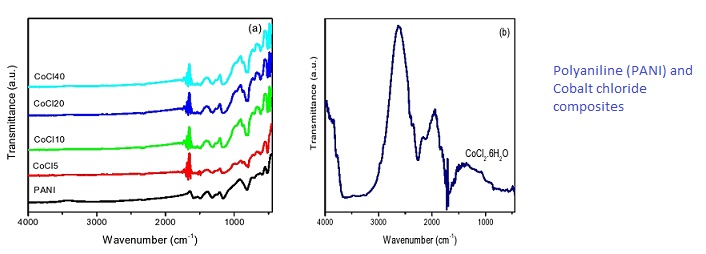
Synthesis and Fourier Transform Infra-Red Spectroscopy of Polyaniline/Cobalt Chloride Composites
Abstract
Polyaniline (PANI) and PANI/cobalt chloride composites were synthesized by in situ chemical oxidative polymerization of aniline with CoCl2.6H2O using ammonium peroxidisulphate as an oxidant. These composites were characterized by Fourier Transform Infrared (FTIR) Spectroscopy. The FTIR results reveal that some of the bands of CoCl2.6H2O are visible separately in PANI/cobalt chloride composites while some other bands got mixed with PANI. Also there exists small shifting in position of PANI peaks in case of composites. Thus, the FTIR results confirm the presence of cobalt chloride in the composites.
Keywords
Full Text:
PDFReferences
P. K. Shen, H. T. Huang, A. C. C. Tseug. A study of tungsten trioxide and polyaniline composite films. J. Electrochem. Soc. 1992, 139, 1840–1845.
H. Kawaguch. Functional polymer microspheres. Prog. Polym. Sci. 2000, 25, 1171–1210.
O. Kalinina, E. Kumacheva. A ‘core-shell’ approach to producing 3D polymer nanocomposites. Macromol. 1999, 32, 4122–4129.
G. Bidan, O. Jarjayes, J. M. Fruchart, E. Hannecart. New nanocomposites based on ‘tailor dressed’ magnetic particles in a polypyrrole matrix. Adv. Mater. 1994, 61, 52–155.
F. Yan, G. Xue, J. Chen, Y. Lu. Preparation of a conducting polymer/ferromagnet composite film by anodic-oxidation method. Synth. Met. 2001, 123, 17– 20.
J. Liu, M. X. Wan. Composites of polypyrrole with conducting and ferromagnetic behaviors. J. Polym. Sci. A: Polym. Chem. 2000, 38, 2734–2739.
M. Wan, J. C. Li. Synthesis and electrical-magnetic properties of polyaniline composites. Journal of Polymer Science Part A: Polymer
Chemistry. 2003, 36, 2799– 2805.
A. G. MacDiarmid. Synthetic metals: a novel role for organic polymers. Synth. Met. 2002, 125, 11-22.
K. Naoi, S. Ogano, T. Osaka. Effect of anion species on electrochemical behavior of poly(aniline)s electropolymerized in dichloroethane solution. J. Electrochem Soc. 1988, 135, 119-124.
S. A. Chen, Y. Fang. Polyaniline Schottky barrier: effect of doping on rectification and photovoltaic characteristics. Synth Met. 1993, 60,
-222.
B. P. Jelle, G. Hagen. Transmission spectra of an electrochromic window based on polyaniline, Prussian blue and tungsten oxide. J Electrochem Soc. 1993, 140, 3560-3564.
C. H. Liu, K. T. Liao, H. Huang. Amperometric immunosensors based on protein. J. Anal Chem. 2000, 72, 2925-2929.
P. N. Adams, P. J. Laughlin, A. P. Monkman, Synthesis of high molecular weight polyaniline at low temperatures. Synth Met. 1996, 76, 157-160.
M. M. Verghese, K. Ramanathan, S. M. Ashraf, M. N. Kamalasanan, B. D. Malhotra. Electrochemical growth of polyaniline in porous sol-gel films. Chem Mater. 1996, 8, 822-824.
K. Gupta, G. Chakraborty, P. C. Jana, A. K. Meikap. Synthesis of copper chloride and cobalt chloride composites of polyaniline and their magnetic and alternating current transport properties. J. Phys. Sci. 2009, 13, 251-260.
R. Ganesan, A. Gedanken. Organic-inorganic hybrid materials based on polyaniline/TiO2 nanocomposites for ascorbic acid fuel cell
systems. Nanotechnology. 2008, 19, 435709-435713.
I. S. Ahuja, R. Singh, C. L. Yadava. Structural information on cobalt(II), Nickle(II), copper(II), zinc(II), silver(I) and cadmium(II) nitrate complexes with hexamethylnetetramine from their magnetic moments, electronic and infrared spectra. J. Mol. Struct. 1980, 68, 333-338.
 ISSN 2321-4635
ISSN 2321-4635